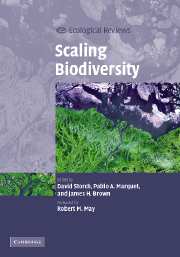Book contents
- Frontmatter
- Contents
- List of contributors
- Foreword by Robert M. May (Lord May of Oxford)
- Preface
- 1 Introduction: scaling biodiversity – what is the problem?
- PART I Spatial scaling of species richness and distribution
- PART II Alternative measures of biodiversity: taxonomy, phylogeny, and turnover
- 7 Biodiversity scaling relationships: are microorganisms fundamentally different?
- 8 The importance of phylogenetic structure in biodiversity studies
- 9 On the quantification of local variation in biodiversity scaling using wavelets
- 10 The scaling of spatial turnover: pruning the thicket
- PART III Scaling of biological diversity with energy and the latitudinal biodiversity gradient
- PART IV Processes, perspectives, and syntheses
- Index
- Plate section
- References
9 - On the quantification of local variation in biodiversity scaling using wavelets
Published online by Cambridge University Press: 05 August 2012
- Frontmatter
- Contents
- List of contributors
- Foreword by Robert M. May (Lord May of Oxford)
- Preface
- 1 Introduction: scaling biodiversity – what is the problem?
- PART I Spatial scaling of species richness and distribution
- PART II Alternative measures of biodiversity: taxonomy, phylogeny, and turnover
- 7 Biodiversity scaling relationships: are microorganisms fundamentally different?
- 8 The importance of phylogenetic structure in biodiversity studies
- 9 On the quantification of local variation in biodiversity scaling using wavelets
- 10 The scaling of spatial turnover: pruning the thicket
- PART III Scaling of biological diversity with energy and the latitudinal biodiversity gradient
- PART IV Processes, perspectives, and syntheses
- Index
- Plate section
- References
Summary
Introduction
It is obvious to even the most casual naturalist that community composition varies through space and that this variation is related in some way to environmental gradients. Yet the problem of understanding in detail patterns of species turnover in space remains a difficult and unsolved challenge in spatial ecology. How do we relate spatial turnover in community composition to the underlying biological processes regulating the origin and maintenance of biological diversity in landscapes? The basic components are simple. If each species is restricted to a unique set of preferred environmental conditions and the environment varies spatially, then in a deterministic world, spatial variation in community composition simply reflects environmental variation. If rates of environmental change are constant, we should find a highly regular and simple pattern of species turnover. The complicating factors are of course ecology, history and variation in the “texture” of the physical environment. Species unable to track a temporally changing environment will be present in suboptimal conditions and missing from the preferred environment (Vetaas, 2002). The vagaries of extinction–recolonization dynamics imply that some fraction of species which could occur in some particular local environment will be missing solely for historical reasons (Hanski & Gyllenberg, 1997). Species may also be absent from preferred habitats because of competitive exclusion or absence of an obligate mutualist (Caley & Schluter, 1997).
- Type
- Chapter
- Information
- Scaling Biodiversity , pp. 168 - 180Publisher: Cambridge University PressPrint publication year: 2007
References
- 3
- Cited by

